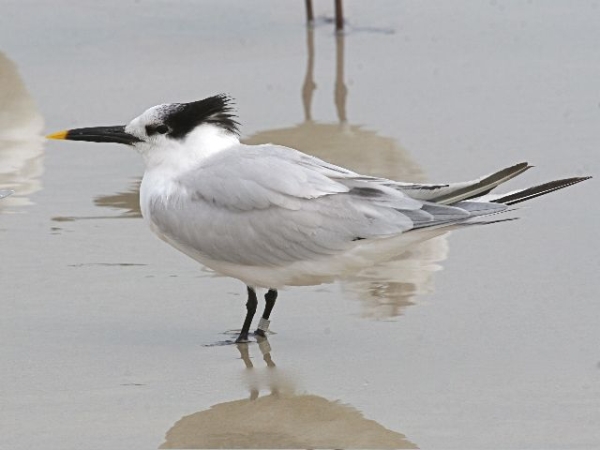
…a closer look.
For as many times as I’d been to Florida I’d never seen a sandwich tern. They may have flown by me in years past, but fast-moving gulls and terns are hard for me to identify. I just don’t see them often enough to be good at it. Pittsburgh is sorely lacking an oceanfront.
Last year Chuck Tague gave me a good tip on identifying terns and I wrote it in my field guide: Look at the bills and legs. What color and shape is the bill? What color are the legs?
Caspian terns are easy. They’re big and stocky and their bills look like fat carrots attached to their faces.
I now see that sandwich terns are easy too. They’re the only “crested” tern with a black bill, and it’s a very fancy one – all black with a yellow tip. This color combination is quite unique. Plenty of birds have black-tipped yellow bills but in searching my field guide I can find only one other bird with a yellow-tipped black bill: the Sabine’s gull. I wonder why.
Another puzzle was their name. Why are they called “sandwich” terns? Isn’t Sandwich in England?
Again, my land-lubber roots were showing. If I lived near the ocean I’d know that seabirds can easily occur worldwide because they find food everywhere there’s salt water – and so it is with sandwich terns. They nest on the coasts of Europe, North and South America, and winter on the coasts of the Americas, the Mediterranean, Africa, India and the Middle East. Birds born here are sometimes found in the Netherlands and U.K. in winter – and vice versa.
This also explains their name, given to them by John Latham in 1787 from a specimen found at Sandwich Bay, Kent, England. Back then they bred there. Interestingly, their Latin name recently changed from Sterna sandvicensis to Thalasseus sandvicensis after DNA tests put them in a different genus. The “sandwich” part remains the same.
At Ponce Inlet I had a good long look at the terns as they stood in a mixed flock facing the wind only 12 feet away. I could easily see how different they were from Forster’s terns. (Click on the photo to see for yourself – a Forster’s tern standing between two sandwich terns.)
And finally, you can tell I’ve been birding with pun-master Chuck Tague for six days because I started this blog with an “almost” pun. I veered away from it just in time.
(photos by Chuck Tague)
I remember them as having “mustard” on their beak….(sandwich)..sorry another pun.